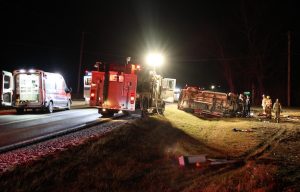WJHS future in flux

With plumbing, HVAC and other maintenance concerns due to the age of the building, the future of Waterloo Junior High School was a key topic at Monday’s school board meeting as a decision will soon need to be made that could affect the district for decades to come.
The meeting began shortly before 7:15 p.m. – a fairly early start time given the previous two months’ hour-long delays – with Waterloo Superintendent of Schools Brian Charron using part of his monthly report to discuss the current situation and future of WJHS.
Discussions surrounding the junior high began earlier this year as the board began discussing the idea of either constructing a new building or conducting substantial renovations on the building which was originally constructed in the 1930s and has seen major additions twice in the following decades.
Charron offered an overview of the situation, with numerous aged components of the junior high requiring vital maintenance, repairs and replacements.
He specifically pointed to the aging HVAC system for which the district is no longer able to find parts for repairs.
“We are already taking parts… we have a few classrooms that are not being used at the junior high, and we are having to salvage parts off of some of that equipment to keep unit ventilators in other classrooms up and running,” Charron said.
Later in the junior high discussion, Charron also brought attention to the plumbing in the building. He noted an incident in which an elbow joint was rusted to the point of developing a hole large enough for water to be spraying out and into the wall, with other pipes in the school being similarly rusted and damaged.
He likewise spoke about the schools electrical system, with the oldest section of the building – like the HVAC system – suffering from a concerning lack of parts.
“In the north part of the junior high, it looks like they were residential quality electrical panels,” Charron said. “Maybe they weren’t, but when the power is off at the junior high and an electrician comes in and starts giggling when they open it up and look at it and figure out where we can find fuses to fit this, it’s complicated, and that is what we’re dealing with.”
The board previously authorized FGM Architects to conduct an analysis for a potential renovation or replacement of the 83-year-old building.
Offering a presentation on the junior high was Aaron Keistler with FGMA, who offered a deep-dive into the analysis that’s been done including cost estimates, a staff survey and an overall evaluation of the benefits and consequences of renovation or new construction.
He expanded on some of the concerns Charron touched on, with major renovations also needed in the windows at the south and middle parts of the building due to settling, doors and other hardware requiring replacement and a large part of the roof likewise demanding work.
Staff input from the survey was also taken into consideration, and it was recognized that fiber internet was also desired alongside new locker rooms, a secure front vestibule and other improvements.
“The general summary of what everyone was saying is they desperately do want some type of upgrade for the building with a focus on the students and the learning environments,” Keistler said. “Updated finishes, updated daylight, updated furniture, try to find a way to make it less crowded in the hallways, more flexible learning spaces both in the classroom as well as other spaces in the building.”
Part of Keistler’s presentation touched on how long a school building should last. He noted how Triad Junior High is set to have its lifespan run through 2027 for a total of 68 years, Mascoutah High School saw 61 years and Columbia High School is currently undergoing substantial renovations at 56 years.
When it comes to a possible renovation of the existing junior high building, such a project would face the problem of being highly invasive, demanding either tight construction windows over multiple summers to avoid disrupting classes or bringing in temporary facilities which would be set up for classes just outside the school.
Construction of a new building would naturally be less disruptive of classes but would come with its own expected problems and decisions such as where to build.
While Keistler noted that the lots shown in his presentation were just meant to show some possible options, seemingly promising builds mainly included a school in a lot neighboring Waterloo High School and a lot that would put the school close to Zahnow Elementary School.
Plenty of conversation, naturally, honed in on the cost of either proposal.
For a renovation of the existing facility, Keistler placed the current estimate at around $42.6 million, with costs rising to $49 million were the district to add more of the requested features and improvements in the years that followed.
The estimate for an entirely new facility came in at around $81.8 million with additional follow-up work bringing the price further up to $89.4 million.
Further on the subject of cost, Charron brought up that the construction of a new building would require the board to place a referendum on a future ballot, seeking voter approval to borrow the money necessary for the project.
While the board could conduct itself similarly with the renovation option, Charron noted that, as the renovations to the junior high chiefly concern health/life safety matters, the district could simply borrow that money in order to make the renovations without voter input.
Charron added that, were voters to turn down a referendum requesting approval for a renovation loan, the district would simply be back where they were, deciding to conduct the renovations or pursue a referendum for new construction.
It was noted that both options have their downsides, with a new building set to incur maintenance costs of its own down the line and renovations requiring considerations to ensure the building is still suitable for the district for the next few decades.
“I’m not here to say that a building can’t last past 100 years if it’s well taken care of,” Keistler said. “They definitely can. I love historic preservation. But a school’s curriculum changes, evolves over time, and a school building needs to be able to evolve over time as well, and that’s all very doable with an existing facility as well as building a brand new one.”
Charron further spoke to the challenge being presented before the board as they make a decision on behalf of students who will be attending the district over the course of the next century.
He additional noted the challenge of this choice as it’s difficult to guess what the needs of the district and community could be in that time, referring to a possible expansion of Route 3 or potential development in the southern portion of Waterloo.
“What’s very difficult, as I mentioned during our building and grounds committee meeting, is that we’re trying to make a decision now to serve kids for 30 years, 60 years, 90 years, all of which are likely beyond my life, and we’re trying to make that decision now,” Charron said. “We don’t know what kind of expansion Waterloo’s gonna have in the future, what kind of growth there’s gonna be.”
Toward the end of the discussion, Charron offered his opinion that the current building is still “worth some investment,” though he acknowledged the oldest part of the building will likely need to be torn down in 30 years, with the board at that time having the chance to create a 5-year plan for such an endeavor.
Further notes from the presentation and discussion included an acknowledgement that the building is still structurally sound and that, while an increase in population would place more demand on school building resources, it would also provide more tax revenue for the district to better accommodate a major project.
Ultimately, the board is set to continue discussing the matter through the near future, with around a year required in order to make a concrete plan to move forward.
It was noted that the public would need to be thoroughly educated on the situation in the months ahead.
For information on other discussion and action items at the Waterloo School Board meeting, read next week’s issue of the Republic-Times.






